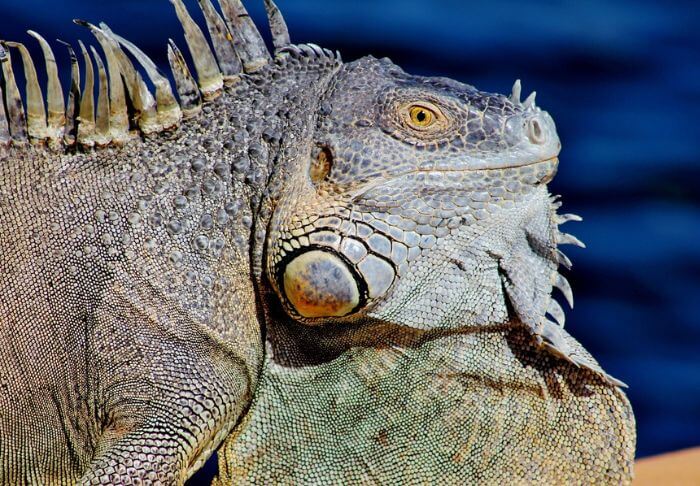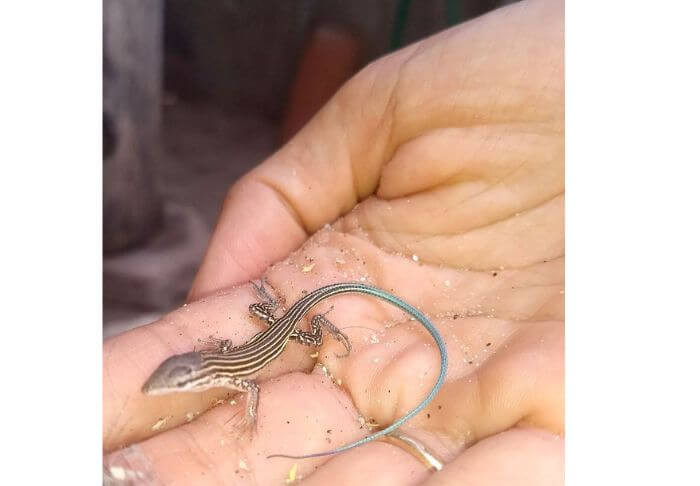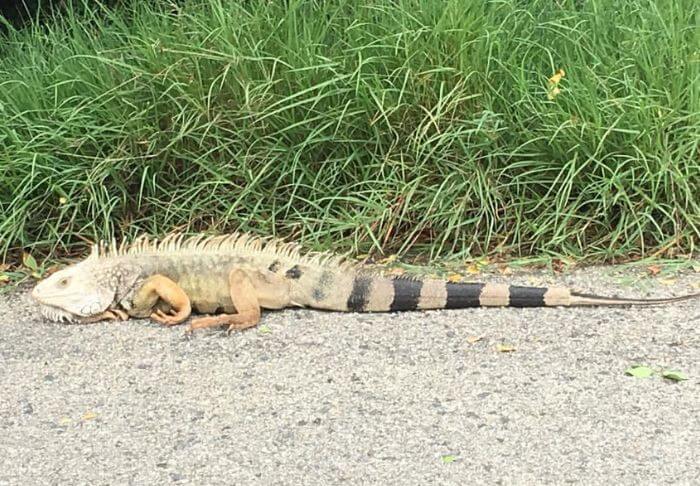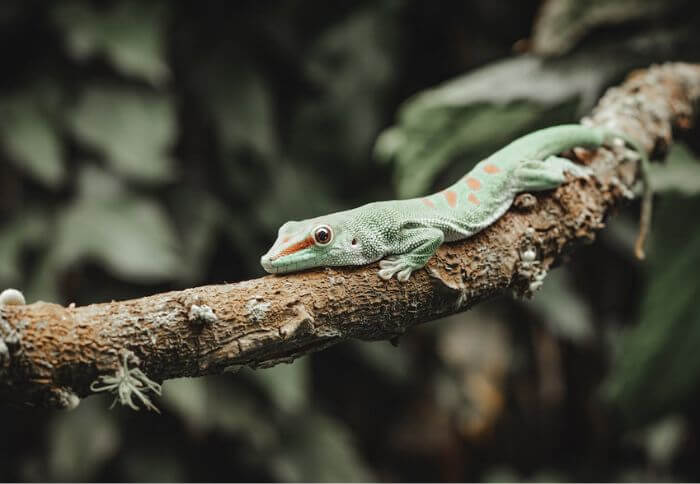Lizards in Puerto Rico (11 Common Species)
Nestled within the lush forests and vibrant landscapes of Puerto Rico, a fascinating array of lizards roam freely, each species with its own unique characteristics and adaptations.
From the colorful Anolis Culebra to the elusive Ameiva, these reptilian inhabitants play an integral role in shaping the island’s diverse ecosystem.
In the article below you’ll learn about common types of lizards in Puerto Rico. Get more details about where you can find them, what they eat and more.
List of Lizards in Puerto Rico
1. Green Iguana

The green iguana, a charismatic resident of this region, captivates the hearts of nature enthusiasts with its vibrant emerald scales and enigmatic behavior.
These arboreal reptiles demonstrate remarkable agility as they navigate through the lush canopies and bask in the Caribbean sunshine.
Despite their graceful appearance, green iguanas are tenacious survivors, adapting to diverse environments ranging from urban areas to remote rainforests.
Furthermore, these majestic creatures play a crucial role in maintaining ecological balance on the island by consuming a varied diet consisting of leaves, fruits, and flowers.
Their presence is not only a testament to the rich biodiversity but also offers an opportunity for conservation efforts to safeguard these enchanting creatures for future generations to admire.
Whether observed lounging on tree branches or gracefully leaping across rugged terrain, the green iguana truly embodies the spirit of resilience and magnificence in Puerto Rico’s verdant landscapes.
2. Puerto Rican Leaf-toed Gecko
The Puerto Rican leaf-toed gecko, or Sphaerodactylus nicholsi, is a remarkable creature that has adapted to thrive in the diverse ecosystems.
This tiny lizard possesses specialized toe pads that allow it to cling effortlessly to various surfaces, from tree trunks to walls, enabling it to navigate its environment with ease.
Its cryptic coloration and small size make it a challenging sight for any observer; yet, if you’re lucky enough to catch a glimpse of this elusive gecko, you’ll be rewarded with a fascinating display of agility and grace.
This gecko’s unique characteristics don’t stop at its physical attributes; its diet primarily consists of insects and spiders, contributing positively to natural pest control in its habitat. Their ability to consume large quantities of pests plays an important role in maintaining ecological balance within their ecosystem.
3. Mona Ameiva
Mona ameiva, a unique species of lizard native to Puerto Rico, has long captivated the attention of biologists and reptile enthusiasts alike.
With its striking appearance and elusive nature, this agile creature has become a subject of fascination for those who study the diverse wildlife of the Caribbean.
The Mona ameiva’s remarkable ability to blend seamlessly into its environment has piqued the curiosity of researchers seeking to understand its evolutionary adaptations for survival in the rugged terrain.
One particularly intriguing aspect of Mona ameiva’s behavior is its complex social structure within colonies. These lizards display intricate patterns of communication and hierarchy, challenging traditional assumptions about reptilian social dynamics.
As more is uncovered about their interactions and behaviors, Mona ameiva continues to reveal itself as a captivating subject for further study and appreciation.
4. Mona skink
The Mona skink, a small lizard species native to the island of Puerto Rico, is a fascinating and often misunderstood creature.
With its sleek brown body and distinctive stripes, this elusive reptile can be found darting through the dense vegetation of the island’s forests and coastal areas. What sets the Mona skink apart from other lizard species is its unique reproductive behavior.
Unlike many lizards that lay eggs, the Mona skink gives birth to live young, making it a remarkable example of viviparity in reptiles.
While the Mona skink may not be as well-known as larger reptile species, its role in the ecosystem is crucial. As an efficient predator of insects and small invertebrates, these lizards help maintain ecological balance on the island.
However, habitat loss and introduced predators pose significant threats to the survival of this species.
Efforts to conserve their natural habitat and protect them from invasive species are essential for ensuring the continued existence of these remarkable creatures in this diverse ecosystem.
5. Mona Anole
The Mona anole, a species of lizard native to Puerto Rico, is a fascinating creature that has evolved to blend in with its surroundings.
This small lizard is known for its ability to change color, ranging from green to brown and even gray, depending on its environment and mood. With keen eyesight and agile movements, the Mona anole is a skilled hunter, preying on insects and small invertebrates in its tropical habitat.
What sets the Mona anole apart is its remarkable ability to communicate through head-bobbing displays.
These gestures are used by males to assert dominance and territory while also serving as courtship rituals. The intricate social interactions and behavioral patterns of these lizards provide valuable insight into their complex social dynamics within their natural ecosystem.
Despite being often overshadowed by other charismatic species of wildlife, the Mona anole’s unique features make it a compelling subject for study and admiration.
6. Blue-tailed Ground Lizard

source: mimitamos
The blue-tailed ground lizard is a remarkable species native to Puerto Rico, known for its vibrant blue tail and agile movements.
Found in the island’s forests and grasslands, this elusive reptile has intrigued scientists and nature enthusiasts alike. Its ability to blend in with its surroundings while showcasing a striking pop of color makes it a truly captivating sight in its natural habitat.
One of the most fascinating aspects of the blue-tailed ground lizard is its unique mating behavior. During courtship displays, males perform impressive push-up movements and head bobs to attract females—an intricate mating ritual that highlights the complexity of their social interactions.
Furthermore, their efficient foraging techniques and hunting skills contribute to maintaining ecological balance within their ecosystem, making them an essential component of the biodiverse landscape.
Overall, the blue-tailed ground lizard serves as a symbol of resilience and adaptation in the face of environmental challenges.
7. Lesser Antillean Iguana

The Lesser Antillean iguana, also known as the West Indian iguana, is a striking reptile that holds a unique place in the diverse ecosystem.
With its vibrant green scales and distinctively long tail, this species has long fascinated researchers and conservationists alike.
Despite facing threats from habitat destruction and invasive predators, efforts to protect and rehabilitate these majestic creatures have given hope for their survival.
Also the Lesser Antillean iguana is its role as an indicator of environmental health. As a keystone species in the region, their presence reflects the overall well-being of the ecosystems they inhabit.
By studying their behavior and population dynamics, scientists gain valuable insights into the complex interplay between wildlife conservation and sustainable development in Puerto Rico.
Furthermore, initiatives aimed at preserving their natural habitats not only benefit these captivating lizards but also contribute to safeguarding the island’s biodiversity for future generations.
Related read: black lizards with blue tails
8. Puerto Rican Iguana

source: thepigroastqueen
The Puerto Rican iguana, also known as the green iguana or iguana verde, is a striking reptile that has become an iconic symbol of the island’s wildlife.
These magnificent creatures are renowned for their vibrant green scales and impressive size, often reaching lengths of over six feet. However, despite their imposing appearance, these iguanas are primarily herbivorous, feeding on a variety of fruits, flowers, and leaves found in the island’s lush tropical environment.
Unfortunately, these stunning reptiles have faced severe population declines in recent years due to habitat loss and hunting pressure. Conservation efforts have been crucial in protecting the remaining populations and raising awareness about the importance of preserving their natural habitat.
9. Crested Anole
The Crested Anole, a fascinating lizard native to Puerto Rico, is a stunning sight to behold with its vibrant green color and unique crest running down its back.
Found in the lush forests and coastal areas of the island, this arboreal species has remarkable adaptability and agility, making it a true marvel of nature. What sets the Crested Anole apart is its ability to change color depending on its environment and mood, showcasing incredible camouflage skills that provide both protection from predators and an impressive display of natural beauty.
Apart from its striking appearance, the Crested Anole plays a crucial role in maintaining ecological balance within the diverse ecosystems.
As an efficient predator of insects, this agile lizard helps control pest populations while serving as prey for larger animals such as birds and snake
s. Its presence in the wild serves as a testament to nature’s brilliance and resilience, showcasing the intricate web of interconnectedness that defines the island’s biodiversity.
With its captivating features and vital ecological role, the Crested Anole stands as one of Puerto Rico’s most iconic reptiles.
10. Emerald Anole

source:gonature92
The emerald anole, also known as the Puerto Rican anole, is a striking lizard species that can be found in the lush forests.
What sets this small and agile creature apart is its dazzling bright green coloration, which provides excellent camouflage among the foliage.
Interestingly, these anoles are known for their ability to change color based on mood, temperature, and environment, adding another layer of fascination to their already captivating presence.
With its slender body and long tail, the emerald anole gracefully maneuvers through the dense vegetation, using its keen eyesight and lightning-fast reflexes to capture prey.
Their acrobatic movements as they climb trees or leap from branch to branch make them a mesmerizing sight in their natural habitat. Moreover, these lizards play a significant role in maintaining ecological balance by controlling insect populations within their environment. The emerald anole’s charm lies not only in its physical beauty but also in its vital contribution to the intricate web of life on this enchanting island.
11. Puerto Rican Skink
The Puerto Rican skink, known scientifically as Spondylurus magnacruzae, is a fascinating native in this region.
With its striking bronze or copper-colored scales and slender body, this skink stands out among the diverse lizard population of the region.
What sets the Puerto Rican skink apart is its unique ability to regrow lost limbs, a remarkable trait that contributes to its resilience in the face of predation and environmental challenges.
Beyond its physical characteristics, the behavior of this skink is equally intriguing. Unlike many other lizard species, this skink exhibits complex social behaviors and forms dynamic group hierarchies within its habitat.
Final thoughts:
The diverse range of lizards in Puerto Rico provides a fascinating glimpse into the island’s rich biodiversity. From the strikingly colored anoles to the elusive dwarf geckos, each species contributes to the delicate balance of the local ecosystem.
Understanding and appreciating these unique creatures is essential for their conservation and protection. By learning about the different types of lizards, we can also gain a deeper appreciation for the natural world around us. Let’s continue to explore and celebrate the incredible diversity of lizards on this beautiful Caribbean island.
Passionate animal photographer with an unwavering love for capturing the essence and beauty of our furry friends.
With over five years of experience in the field, I have developed a unique ability to connect with animals on a deeper level, allowing me to create stunning and captivating images that truly reflect their personality.
Let’s collaborate to capture unforgettable moments that celebrate the unique bond between humans and animals!


